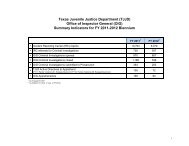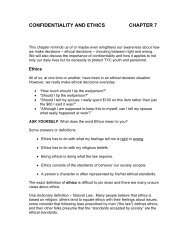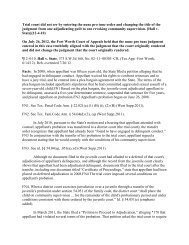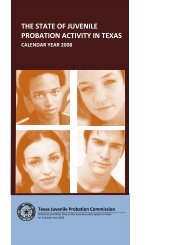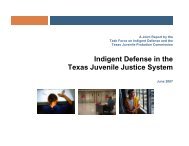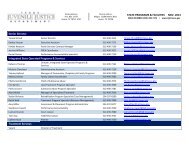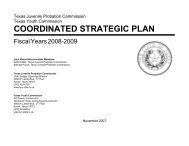Factors in the Needs Assessment - Texas Juvenile Justice Department
Factors in the Needs Assessment - Texas Juvenile Justice Department
Factors in the Needs Assessment - Texas Juvenile Justice Department
Create successful ePaper yourself
Turn your PDF publications into a flip-book with our unique Google optimized e-Paper software.
Data Coord<strong>in</strong>ators Workshop, 2009
Topics Covered<br />
• Background<br />
• Purpose and Use<br />
• Description of <strong>the</strong> <strong>Assessment</strong> Form<br />
• <strong>Factors</strong> <strong>in</strong> <strong>the</strong> Risk <strong>Assessment</strong><br />
• <strong>Factors</strong> <strong>in</strong> <strong>the</strong> <strong>Needs</strong> <strong>Assessment</strong><br />
• Case Management Component<br />
• Work<strong>in</strong>g Through an Example<br />
• Pilot Sites<br />
2
Background<br />
• TJPC developed <strong>the</strong> Risk and <strong>Needs</strong> <strong>Assessment</strong><br />
Instrument based on data collected from juvenile<br />
probation departments throughout <strong>the</strong> state<br />
• Thirty-one departments, 46 counties<br />
• Information was collected on 3,047 juveniles<br />
3
Background<br />
• <strong>Department</strong>s were selected for <strong>the</strong> study<br />
• Mix of small, medium and large departments<br />
• All regions of state represented<br />
• <strong>Juvenile</strong> cases were sampled<br />
• Representative number of girls and boys, high risk and<br />
low risk offenders<br />
4
Background<br />
• The study lead<strong>in</strong>g to <strong>the</strong> <strong>Assessment</strong> began with all<br />
juveniles formally referred to juvenile probation <strong>in</strong> 2003<br />
• <strong>Juvenile</strong>s tracked for three years to determ<strong>in</strong>e number of<br />
subsequent referrals/arrests<br />
• <strong>Juvenile</strong>s tracked <strong>in</strong>to <strong>the</strong> adult system<br />
6
Background<br />
• Collected <strong>in</strong>formation on selected juveniles from <strong>the</strong><br />
files<br />
• Demographic, school, peers, substance abuse, abuse and<br />
neglect, mental health, family, victims, placements, risk<br />
and protective factors<br />
• Also had data from TJPC monthly extract and o<strong>the</strong>r<br />
state agencies<br />
7
Background<br />
• Analysis conducted to determ<strong>in</strong>e those factors that were<br />
most predictive of re-offense<br />
• <strong>Factors</strong> for boys and girls analyzed separately<br />
• Focus on identify<strong>in</strong>g “chronic” offenders<br />
• Chronic def<strong>in</strong>ed as three or more subsequent offenses <strong>in</strong> a<br />
three year period<br />
8
Background<br />
• A Risk and <strong>Needs</strong> <strong>Assessment</strong> was developed<br />
• <strong>Assessment</strong> <strong>in</strong>cludes 11 risk and 7 needs factors for boys,<br />
10 risk and 7 needs factors for girls<br />
• Separate assessment for males and females<br />
• <strong>Assessment</strong> valid for juveniles <strong>in</strong> <strong>Texas</strong><br />
9
Purpose and Use<br />
10
Purpose of Risk <strong>Assessment</strong><br />
• The Risk <strong>Assessment</strong> is designed to identify juveniles<br />
who are at risk of becom<strong>in</strong>g chronic offenders<br />
• <strong>Assessment</strong> classifies a juvenile’s risk as “Low” , “Medium”<br />
or “High”<br />
11
Percent Chronic<br />
Boys Girls<br />
Low Risk 14% 9%<br />
Medium Risk 42% 37%<br />
High Risk 67% 69%<br />
Total All Chronic 36% 30%<br />
12
Proportion Of Risk Levels<br />
Boys<br />
Girls<br />
Low Risk 36% 40%<br />
Medium Risk 47% 47%<br />
High Risk 17% 13%<br />
Total All Chronic 100% 100%<br />
13
Purpose of <strong>Needs</strong> <strong>Assessment</strong><br />
• The <strong>Needs</strong> <strong>Assessment</strong> identifies factors that, although<br />
not predictive of re-offense, target juveniles for more<br />
<strong>in</strong>tensive or specialized services<br />
• <strong>Assessment</strong> classifies <strong>the</strong> needs of <strong>the</strong> juvenile <strong>in</strong>to “Low”,<br />
“Medium” and “High”<br />
14
Purpose of <strong>Assessment</strong> Instrument<br />
• The assessment is designed to help departments<br />
determ<strong>in</strong>e <strong>the</strong> appropriate supervision and services for<br />
juveniles<br />
• Identification of youth most at risk of committ<strong>in</strong>g<br />
subsequent offenses allows for target<strong>in</strong>g of supervision<br />
and services<br />
• Identification of youth with highest levels of need allows<br />
for target<strong>in</strong>g of programs and services<br />
15
Purpose of <strong>Assessment</strong> Instrument<br />
• Ultimate purpose of assessment <strong>in</strong>strument is to reduce<br />
recidivism<br />
• Target<strong>in</strong>g supervision and services early ra<strong>the</strong>r than later<br />
for medium and high risk juveniles should reduce<br />
recidivism<br />
16
Use of <strong>Assessment</strong> Instrument<br />
• <strong>Assessment</strong> Instrument should be completed prior to<br />
<strong>the</strong> disposition of a juvenile’s case<br />
• “A juvenile probation department must, before <strong>the</strong> disposition<br />
of a child's case and us<strong>in</strong>g a validated risk and needs assessment<br />
<strong>in</strong>strument or process provided or approved by <strong>the</strong> commission,<br />
complete a risk and needs assessment for each child under <strong>the</strong><br />
jurisdiction of <strong>the</strong> juvenile probation department.”<br />
17
Percent Chronic by Disposition<br />
Disposition<br />
Percent Chronic<br />
Dismissed 35%<br />
Supervisory Caution 37%<br />
Deferred 22%<br />
Probation 39%<br />
TYC/ Certified as an Adult* 18%<br />
Total 33%<br />
*Information was not available on all juveniles sent to TYC or certified as an adult<br />
18
Use of <strong>Assessment</strong> Instrument<br />
• TJPC will be mak<strong>in</strong>g rules concern<strong>in</strong>g <strong>the</strong> use of <strong>the</strong><br />
<strong>Assessment</strong> Instrument<br />
• Until approved by <strong>the</strong> TJPC Board, <strong>Department</strong>s can set<br />
<strong>the</strong>ir own policy for when and for whom <strong>the</strong> assessment<br />
will be given<br />
19
Use of <strong>Assessment</strong> Instrument<br />
• Recommend <strong>the</strong> <strong>Assessment</strong> Instrument be completed<br />
as part of <strong>the</strong> disposition decision process<br />
• At a m<strong>in</strong>imum, all juveniles with a recommendation of<br />
community supervision, placement or TYC commitment<br />
should have an assessment<br />
20
Use of <strong>the</strong> <strong>Assessment</strong> Instrument<br />
• The assessment itself will take only m<strong>in</strong>utes to complete<br />
IF<br />
• <strong>the</strong> <strong>in</strong>formation about <strong>the</strong> juvenile has been ga<strong>the</strong>red<br />
completely!<br />
21
Use of <strong>the</strong> <strong>Assessment</strong> Instrument<br />
• It is important to complete <strong>the</strong> assessment as accurately<br />
and thoroughly as possible<br />
• It is important to use <strong>the</strong> most current <strong>in</strong>formation<br />
available for <strong>the</strong> juvenile<br />
• Incomplete or <strong>in</strong>accurate <strong>in</strong>formation used <strong>in</strong> <strong>the</strong><br />
assessment <strong>in</strong>strument will result <strong>in</strong> errors <strong>in</strong> <strong>the</strong><br />
juvenile’s risk and needs classification<br />
22
Use of <strong>the</strong> <strong>Assessment</strong> Instrument<br />
• It is also essential that all staff complet<strong>in</strong>g <strong>the</strong><br />
assessment use <strong>the</strong> same def<strong>in</strong>itions for each of <strong>the</strong><br />
factors <strong>in</strong>cluded on <strong>the</strong> assessment<br />
• Differences <strong>in</strong> <strong>the</strong> <strong>in</strong>terpretation of risk and need factors<br />
will lead to similar juveniles be<strong>in</strong>g classified differently<br />
23
Use of <strong>the</strong> <strong>Assessment</strong> Instrument<br />
• Upon completion of <strong>the</strong> assessment <strong>the</strong> juvenile will<br />
have an assigned Risk and <strong>Needs</strong> level<br />
• At a m<strong>in</strong>imum:<br />
• Recommend supervision and services for “Medium” or<br />
“High” Risk and/or <strong>Needs</strong> juveniles<br />
24
Description of <strong>the</strong> <strong>Assessment</strong> Form<br />
25
• The Risk and <strong>Needs</strong> <strong>Assessment</strong> form should be<br />
completed electronically<br />
• A paper copy of <strong>the</strong> form can be used to ga<strong>the</strong>r <strong>the</strong><br />
<strong>in</strong>formation needed<br />
• The electronic form requires that each field be<br />
completed<br />
• Automatic error check<strong>in</strong>g prohibits <strong>the</strong> entry of most<br />
<strong>in</strong>correct <strong>in</strong>formation<br />
• Scores are calculated for <strong>the</strong> user<br />
26
Electronic Form<br />
27
Paper Form - Male<br />
28
Paper Form - Female<br />
29
Complet<strong>in</strong>g <strong>the</strong> <strong>Assessment</strong> Form<br />
• The assessment is divided <strong>in</strong>to three sections:<br />
• Part I: <strong>Juvenile</strong> Information<br />
• Part II: Risk <strong>Assessment</strong><br />
• Part III: <strong>Needs</strong> <strong>Assessment</strong><br />
• The electronic form also has a section that provides<br />
<strong>in</strong>formation for Case Management<br />
30
<strong>Factors</strong> <strong>in</strong> <strong>the</strong> Risk <strong>Assessment</strong><br />
31
<strong>Factors</strong> and Scor<strong>in</strong>g<br />
• <strong>Factors</strong> determ<strong>in</strong>ed by <strong>the</strong>ir ability to<br />
predict chronic re-offense<br />
• Scor<strong>in</strong>g determ<strong>in</strong>ed by <strong>the</strong> degree to which<br />
<strong>the</strong>y predicted re-offense<br />
32
Risk <strong>Factors</strong><br />
Age at First Referral<br />
Total Referrals to <strong>Juvenile</strong> Probation<br />
Drug Use<br />
Parent Guardian Supervision/ Control<br />
Parent has a Crim<strong>in</strong>al History<br />
Number of Prior Runaways<br />
Number of School Discipl<strong>in</strong>e Referrals <strong>in</strong> Past Year<br />
Ever Failed a Grade<br />
<strong>Juvenile</strong> is Chronically Truant<br />
<strong>Juvenile</strong>’ Peers<br />
<strong>Juvenile</strong> Exhibits Aggressive Behavior<br />
33
Age at First Referral<br />
Boys<br />
10-12 years=2<br />
13-15 years=1<br />
16 years or older=0<br />
Girls<br />
10-11 years=4<br />
12-13 years=3<br />
14-15 years=2<br />
16 years or older=0<br />
34
Total Referrals to <strong>Juvenile</strong> Probation<br />
Boys<br />
4 or more referrals=1<br />
1 to 3 referrals=0<br />
Girls<br />
4 or more referrals=1<br />
1 to 3 referrals=0<br />
35
Drug Use<br />
Boys<br />
Frequent use=3<br />
Occasional use=2<br />
None or rare=0<br />
Girls<br />
Frequent use=4<br />
Occasional use=3<br />
None or rare=0<br />
36
Parent Guardian Supervision/ Control<br />
Boys<br />
No control=3<br />
Some difficulty<br />
controll<strong>in</strong>g=2<br />
Mostly effective=0<br />
Girls<br />
No control=4<br />
Some difficulty<br />
controll<strong>in</strong>g=2<br />
Mostly effective=0<br />
37
Parent Has a Crim<strong>in</strong>al History<br />
Boys<br />
Prior history=1<br />
No prior history=0<br />
Girls<br />
Prior history=1<br />
No prior history=0<br />
38
Number of Runaways<br />
Boys<br />
1 or more runaways=1<br />
No runaways=0<br />
Girls<br />
2 or more runaways=2<br />
1 runaways=1<br />
No runaways=0<br />
39
Number of School Discipl<strong>in</strong>e<br />
Referrals <strong>in</strong> Past Year<br />
Boys<br />
9 or more referrals=2<br />
3 to 8 referrals=1<br />
0 to 2 referrals=0<br />
Girls<br />
9 or more referrals=2<br />
3 to 8 referrals=1<br />
0 to 2 referrals=0<br />
40
Ever Failed a Grade<br />
Boys<br />
Yes=1<br />
No=0<br />
Girls<br />
Yes=1<br />
No=0<br />
41
<strong>Juvenile</strong> is Chronically Truant<br />
Boys<br />
Yes=1<br />
No=0<br />
Girls<br />
Yes=1<br />
No=0<br />
42
<strong>Juvenile</strong>’s Peers<br />
Boys<br />
Negative=1<br />
Positive or mixed=0<br />
Girls<br />
Negative=1<br />
Positive or mixed=0<br />
43
<strong>Juvenile</strong> Exhibits Aggressive<br />
Behavior<br />
Boys<br />
Yes=1<br />
No=0<br />
Girls<br />
Yes=0*<br />
No=0<br />
*Matters for case management<br />
44
Risk <strong>Assessment</strong> Scor<strong>in</strong>g and Levels<br />
Boys<br />
0-5=Low<br />
6-11=Medium<br />
12-18=High<br />
Girls<br />
0-7=Low<br />
8-14=Medium<br />
15-21=High<br />
45
<strong>Factors</strong> <strong>in</strong> <strong>the</strong> <strong>Needs</strong> <strong>Assessment</strong><br />
46
<strong>Needs</strong> <strong>Assessment</strong><br />
• The factors <strong>in</strong>cluded <strong>in</strong> <strong>the</strong> needs assessment are<br />
<strong>in</strong>dicators that <strong>the</strong> juvenile may be <strong>in</strong> need of services<br />
and/or programs<br />
• The presence or absence of factors determ<strong>in</strong>es <strong>the</strong><br />
juvenile’s need for department supervision and/or<br />
programs<br />
• <strong>Needs</strong> are <strong>the</strong> same for both boys and girls<br />
47
<strong>Needs</strong> <strong>Factors</strong><br />
Prior Traumatic Events Yes=1 No=0<br />
Mental Health <strong>Needs</strong> Yes=2 No=0<br />
Current Offense is a Violent Felony Yes=2 No=0<br />
Fail<strong>in</strong>g Under Community Supervision Yes=2 No=0<br />
Sibl<strong>in</strong>g has a Crim<strong>in</strong>al History Yes=1 No=0<br />
Frequent Substance Use Yes=2 No=0<br />
Currently Fail<strong>in</strong>g Two or More Subjects<br />
<strong>in</strong> School<br />
Yes=1 No=0<br />
48
<strong>Needs</strong> <strong>Assessment</strong> Scor<strong>in</strong>g & Levels<br />
Boys<br />
0-1=Low<br />
2-4=Medium<br />
5-11=High<br />
Girls<br />
0-1=Low<br />
2-4=Medium<br />
5-11=High<br />
49
Case Management Component<br />
50
Case Management<br />
• Case management doma<strong>in</strong> areas appear <strong>in</strong> <strong>the</strong> bottom<br />
right section of <strong>the</strong> form as risk and needs factors are<br />
completed<br />
• The areas that appear relate to <strong>the</strong> factors that make <strong>the</strong><br />
juvenile at risk of re-offense and/or <strong>in</strong>dicate areas of<br />
need<br />
51
Case Plan Doma<strong>in</strong>s<br />
• Case management doma<strong>in</strong> areas <strong>in</strong>clude:<br />
• Safety/Security<br />
• Education<br />
• Mental / Behavioral Health<br />
• Substance Abuse<br />
• Family Services<br />
52
Case Plan Doma<strong>in</strong>s<br />
• Case management doma<strong>in</strong>s allow probation staff to<br />
target services for <strong>the</strong> juvenile be<strong>in</strong>g assessed<br />
BUT<br />
• The doma<strong>in</strong>s that appear may not be <strong>the</strong> most<br />
appropriate area from which to address <strong>the</strong> juvenile’s<br />
needs<br />
53
Risk <strong>Factors</strong> & Case Plan Doma<strong>in</strong>s<br />
Risk/Need Factor<br />
Drug Use: Frequent<br />
Parent/Guardian Supervision:<br />
Some Difficulty Controll<strong>in</strong>g<br />
and No Control<br />
Parent Crim<strong>in</strong>al History<br />
Runaway: Two or more<br />
School Discipl<strong>in</strong>e Referrals:<br />
Three or more<br />
Chronically Truant<br />
<strong>Juvenile</strong> Aggressive Behavior<br />
Case Plan Doma<strong>in</strong><br />
Substance Abuse<br />
Family Services<br />
Family Services<br />
Family Services<br />
Education<br />
Education<br />
Safety/Security<br />
54
Need <strong>Factors</strong> & Case Plan Doma<strong>in</strong>s<br />
Risk/Need Factor<br />
Prior Traumatic Events<br />
Mental Health <strong>Needs</strong><br />
Current Offense a Violent<br />
Felony<br />
Sibl<strong>in</strong>g Crim<strong>in</strong>al History<br />
Frequent Substance Use<br />
Currently Fail<strong>in</strong>g 2+ Subjects<br />
Case Plan Doma<strong>in</strong><br />
Mental/Behavioral Health<br />
Mental/Behavioral Health<br />
Safety/Security<br />
Family Services<br />
Substance Abuse<br />
Education<br />
55
Target<strong>in</strong>g Supervision and Services<br />
• <strong>Assessment</strong> is designed to assist <strong>in</strong> <strong>the</strong> delivery of<br />
supervision and services<br />
• Recommend that supervision and services be targeted<br />
based on a juvenile’s risk and needs levels<br />
56
Target<strong>in</strong>g Supervision and Services<br />
• <strong>Department</strong> can develop a matrix of recommended<br />
supervision levels for juveniles at each risk level<br />
classification<br />
• <strong>Department</strong> can develop a suggested program and<br />
service matrix for juveniles with medium and high levels<br />
of need<br />
57
Work<strong>in</strong>g Through an Example<br />
58
Work<strong>in</strong>g Through an Example<br />
• Charles Schmidt was referred to <strong>the</strong> department on<br />
August 1, 2009 for possession of marijuana (MA)<br />
• Charles is a 13 year old white male born on March 5,<br />
1996<br />
• Charles was assigned <strong>the</strong> PID number 4321 for his<br />
referral. The referral number for this offense is 00213.<br />
59
Risk Factor Information<br />
• Charles and his mo<strong>the</strong>r provided <strong>in</strong>formation to <strong>the</strong><br />
officer at <strong>in</strong>take<br />
• Charles and his family moved to <strong>the</strong> area last year.<br />
He lives with his mo<strong>the</strong>r and 2 older bro<strong>the</strong>rs. The<br />
family does not currently have contact with Charles’<br />
fa<strong>the</strong>r – he is currently on parole and liv<strong>in</strong>g <strong>in</strong><br />
Oklahoma.<br />
• Charles has a prior referral <strong>in</strong> Travis County for<br />
shoplift<strong>in</strong>g. The referral occurred <strong>in</strong> April 2008.<br />
60
Risk Factor Information<br />
• Charles’ mo<strong>the</strong>r reports that he is a good boy<br />
although he does not always follow her rules or do<br />
his chores. She reports that he argues with she and<br />
his bro<strong>the</strong>rs a lot but is not physically aggressive.<br />
• Charles does leave home without permission and<br />
stays out past his curfew. He has one prior runaway.<br />
He has begun hang<strong>in</strong>g out with friends that his<br />
mo<strong>the</strong>r does not approve of.<br />
61
Risk Factor Information<br />
• Charles’ mo<strong>the</strong>r reports that Charles does not use<br />
drugs or alcohol although at least one of his older<br />
bro<strong>the</strong>rs uses marijuana<br />
• Charles reports that his friends are use drugs daily<br />
but he has only experimented with drugs once or<br />
twice. He claims that he does not dr<strong>in</strong>k alcohol.<br />
62
Risk Factor Information<br />
• Charles does not like school but claims to attend<br />
regularly and to be pass<strong>in</strong>g all of his classes except<br />
math. He repeated <strong>the</strong> 6 th grade last year and is<br />
currently <strong>in</strong> <strong>the</strong> 7 th grade at Smiley Middle School.<br />
• Charles’ mo<strong>the</strong>r reports that he was <strong>in</strong> trouble last<br />
year for not go<strong>in</strong>g to class and for be<strong>in</strong>g disruptive.<br />
He was never expelled but she th<strong>in</strong>ks that he was<br />
suspended at least three times dur<strong>in</strong>g <strong>the</strong> last<br />
semester.<br />
63
<strong>Needs</strong> Factor Information<br />
• Charles’ mo<strong>the</strong>r states that <strong>the</strong> family has never been<br />
<strong>in</strong>volved with CPS. She did say that her ex-husband<br />
was very abusive and was arrested on numerous<br />
occasions for assault domestic violence. Charles was<br />
8 when she left her husband. At this time Charles’<br />
fa<strong>the</strong>r was sentenced to prison. He has not had<br />
contact with his fa<strong>the</strong>r s<strong>in</strong>ce that time.<br />
• Charles’ fa<strong>the</strong>r is <strong>in</strong> <strong>the</strong> only family member with a<br />
crim<strong>in</strong>al history.<br />
64
<strong>Needs</strong> Factor Information<br />
• Charles’ grandmo<strong>the</strong>r, whom <strong>the</strong> family lived with<br />
s<strong>in</strong>ce mov<strong>in</strong>g to <strong>the</strong> area, passed away last month<br />
after a brief illness.<br />
• Charles was given <strong>the</strong> MAYSI at <strong>in</strong>take. He scored <strong>in</strong><br />
<strong>the</strong> caution range for somatic compla<strong>in</strong>ts and for<br />
alcohol/drug use. He does not have suicidal<br />
ideations.<br />
65
<strong>Needs</strong> Factor Information<br />
• Charles is not currently under supervision. He was<br />
placed on deferred <strong>in</strong> Travis County for shoplift<strong>in</strong>g <strong>in</strong><br />
2008. He completed this supervision.<br />
• School records <strong>in</strong>dicate that Charles is currently<br />
fail<strong>in</strong>g math, science and social studies. His<br />
attendance is poor – he has missed 15 days/partial<br />
days so far this semester.<br />
66
Pilot Sites<br />
67
Pilot Sites<br />
• Began with Dallas <strong>in</strong> June 2009<br />
• F<strong>in</strong>ish with Cameron <strong>in</strong> October 2008<br />
• Hope to learn what works and what doesn’t<br />
work<br />
• What is practical and what is impractical<br />
• What are <strong>the</strong> best uses of <strong>the</strong> <strong>in</strong>strument<br />
• Correct any glitches<br />
69
For Assistance or Questions<br />
Contact:<br />
• Nancy Arrigona 512-424-6738<br />
nancy.arrigona@tjpc.state.tx.us<br />
• John Posey 512-424-6681<br />
john.posey@tjpc.state.tx.us<br />
70





